Inakustik AmbienTone No.1 Bedienungsanleitung
- Typ
- Bedienungsanleitung

2008
AmbienTone No.1
Bedienungs- & Montageanleitung
Operating & Assembly Instructions

AmbienTone No.1
Bedienungs- & Montageanleitung
Seite 3-8
Operating & Assembly Instructions
Page 9-15
2

AmbienTone No.1
AmbienTone –
das ist die Klangwand für SIE und IHN. Für Frauen, weil sie sich oft
an Lautsprecherboxen stören. Für Männer, weil sie auf perfekte Technik und
Klangqualität nicht verzichten wollen. AmbienTone macht sie beide glücklich.
AmbienTone erfüllt Räume mit Klän
gen, die aus dem Nichts zu kommen scheinen.
Keine sichtbaren Lautsprecher stören das Ambiente. Große Flächen bieten sich an
für eine stilvolle Einrichtung.
Und immer wieder erregt AmbienTone das Staunen aller, die den Raum betreten,
die die Klangquelle suchen und fasziniert vor nackten Wänden stehen.
3

AmbienTone No.1 -
Montageanleitung
AmbienTone ist ein Flachmembranlautsprecher in einer modifizierten Gips
-
kartonplatte. Installiert wird er im Trockenbau. In wenigen Verarbeitungs
-
schritten.
Einmal angeschlossen, eingesetzt und verspachtelt, lässt sich AmbienTone
problemlos tapezieren, überstreichen und sogar verputzen. Ein bis zu 2 mm
starker Wandauftrag hat nahezu keine Klangeinbuße zur Folge.
Einbauempfehlung
Anmerkung: Dies ist eine verkür
zte, allgemeine Beschreibung der
Vorgehensweise. Installateure und Auftragnehmer müssen unbedingt die
individuellen Materialien und Gegebenheiten vor Ort berücksichtigen!
Schritt 1:
•
Funktionskontrolle vor dem Einbau in die
Trockenbaukonstruktion.
• Lautspr
echersystem durch sorgfältige Sichtkontrolle auf äußere Mängel
überprüfen.
•
Die 2 Transportsicherungen an der Rückseite des
Lautsprechersystems entfernen.
•
Das Lautsprechersystem auf lose Innenteile überprüfen. Zur Überprüfung
das Lautsprechersystem in bei
de Hände nehmen und nach allen
Richtungen gerade so stark hin und her schütteln, dass eventuell
vorhandene lose Teile durch das Schütteln im Inneren des Lautsprechers
anschlagen und ein Geräusch verursachen würden. Entsprechende
Geräusche weisen auf einen
Mangel hin, da sich im mangelfreien
Lautsprecher keine geräuschverursachenden losen Teile befinden.
•
Lautsprechersystem auf elektrische Funktion überprüfen. Dazu
Lautsprecher an einen Audioverstärker anschließen und über diesen ein
beliebiges Audio–Testsig
nal abspielen. Dabei auf die fehlerfreie
Wiedergabe des Testsignals, insbesondere auf ungewollte
Nebengeräuschen sowie Verzerrungen, achten.
• Lautsprechersystem nach den Vorgaben in der Einbauanleitung einbauen.
•
Beim Anschluß auf die richtige Polarität (
+/
-
) achten
4

Schritt 2:
Zunächst die Wand mit Metallprofilen vorbereiten.
Stellen Sie einen Ausschnitt in
einer Gipskartonbeplankung her (Decke oder Wand), der umlaufend ca. 5 mm
größer ist, als de
r AmbienTone Lautsprecher.
Für die Unterkonstruktion und Beplankung
gelten die jeweiligen Herstelleranweisungen.
Stellen Sie sicher, dass die Unterkonstruktion
der Gipskartonbeplankung so beschaffen ist,
dass sie durch die Vibrationen des
Lautsprechers nic
ht scheppert. Achten Sie
deshalb insbesondere darauf, dass sich keine
losen Teile in oder an der Unterkonstruktion
befinden oder mit dieser in Berührung stehen
und dass der Lautsprecher rückseitig durch
nichts berührt wird.
Schritt 3:
Entfernen Sie die 2 an der Rückseite des Lautsprechers befindlichen
Transportsicherungen und testen Sie den Lautsprecher auf seine einwandfreie
Funktion. Nehmen Sie den elektrischen
Anschluss des Lautsprechers vor !! Legen Sie
d
en Lautsprecher in den vorbereiteten
Ausschnitt ein. Um eine optimale Verbindung
zwischen AmbienTone-
Lautsprecher und
Fugenspachtelmasse zu erreichen, beachten
Sie bitte die Hinweise des
Spachtelmasseherstellers bezüglich der
Kantenpräparation der zu versp
achtelnden
Gipskartonplatten. (z.B. Anschrägen der
umlaufenden Kanten)
5

Schritt 5:
Verspachteln Sie die Fuge nach den Angaben
des Platten- bzw. Spachtelherstellers.
Wie em
pfehlen die Verwendung von
Fugendeckstreifen.
Schritt 6:
AmbienTone und die Trockenbauwand nach
Wunsch streichen, tapezieren oder verputzen.
Schritt 4:
Verschrauben Sie den Lautsprecher mit den
vorhande
nen Metallprofilen. Verwenden Sie
hierfür vorzugsweise handelsübliche
Schnellbauschrauben. Schraubenabstand ca.
10 cm.
6

Wandkonstruktion
Metallständer
-
konstruktion
Dämmung
AmbienTone
-
Pannel
Rahmenkonstruktion
(Wechsel)
Beplankung mit
Gipsbauplatten
7

Technische Daten
AmbienTone No.1 ist ein Flachmembranlautsprecher auf Basis eines Biegewellen
-
wandlers, integriert in eine Gipskartonplatte, die in Trockenbauwe
ise installiert
wird. Ideal bei Neubau, Umbau, Renovierung oder Sanierung.
•
Träger: 12,5
-
mm
-
Gipskartonplatte
• Größe: 700 x 500 x 44 mm (H x B x T)
• Gewicht: ca. 5,8 kg
• System: 2 Wege
• Leistung: 40 Watt
• Impedanz: 4 Ohm
• Frequenzbereich: 80 –18.000 Hz
• Anschluss: 10 m LS Kabel; je nach Charge sind
die Kabel eckig (+) / rund (-) oder farblich
codiert.
8

AmbienTone
AmbienTone – it’s the sound wall for HER and HIM. For women, because they are
often annoyed by speaker cabinets. For men, because they can’t do without
consummate technology and sound quality. AmbienTone makes them both happy.
AmbienTone fills the room with sound that seems to come from nowhere. There
are no speakers visible to spoil the ambience. Broad expanses lend themselves to
stylish interior decoration.
And AmbienTone causes the amazement of all who enter the room, look for the
sound source and stand fascinated before bare walls.
9

TONE
AM
BIEN
AmbienTone-Assembly Instructions
AmbienTone is a flat panel loudspeaker in a modified gypsum plasterboard. It is
installed into a drywall constructions. And in just a few work steps.
Once connected, fitted and spackled, AmbienTone can be wallpapered over, painted
and even plastered over. A coat of up to a thickness of 2 mm will result in only a
minimal loss of sound quality.
Installation guide
Note: This is a brief, general descr
iption of the procedures. Fitters and contractors
must take the individual materials and circumstances on site into consideration!
Step 1:
• Perform function check before fitting into drywall constructions.
• Carefully inspect the loudspeaker system for exterior defects and damage.
• Remove the 2 transport locks on the rear of the loudspeaker system.
•
Check whether there are any loose parts in the loudspeaker system. To do so,
pick up the loudspeaker system in both hands and shake it in all directions so
that any
loose parts within the loudspeaker will make a noise as they hit the
sides. Any noise would indicate a defect, as loudspeakers free of defects do
not contain any loose components which might make noise.
• Check the electrical functions of the loudspeaker s
ystem. To do this, connect
the loudspeakers to an audio amplifier and play a 'continuous sweep' audio
test signal over them. Pay attention to the reproduction of the known test
signal. In particular, make sure there are no unwanted side noises and
distortions.
• Fit the loudspeaker system according to the installation instructions.
• Pay attention to the polarity (+/-) when connecting the cable.
10

Step 2:
The wall must first be prepared with metal profiles. Create a recess in a gypsum
plaster board (ceiling or wall), which is approx. 5 mm larger than the AmbienTone
loudspeaker all the way around. For the
substructure and covering, observe the
relevant manufacturer instructions. Make s
ure
that the substructure of the plasterboard
covering is such that it will not rattle from the
vibrations of the loudspeaker. For this reason,
make sure that no loose objects are located in
or on the substructure or are in contact with its
surface and ens
ure that nothing is touching the
back of the loudspeaker.
Step 3:
Remove the 2 transport locks located
on the back of the loudspeaker and check
that the loudspeaker is functioning correctly. Make sure to connect the
loudspeaker!
Place the loudspeaker in the prepared recess.
In order to achieve an optimum bond between
the Am
bienTone loudspeakers and the
smoothing cement, please observe the
directions of the filler manufacturer with regard
to edge preparation of the plasterboards you
want to spackle. (e.g. folding of the edge
where the speaker is inserted)
11

Step 5:
Spackle the groove in accordance with the
directions of the plasterboard and filler
manufacturers.
We recommend the usage of gap covering duct
tape.
Step 6:
Paint, wallpaper or plaster over AmbienTone and
the drywall construction in any desired colour.
Step 4:
Secure the loudspeakers by screwing them
onto the existing metal profiles. Standard,
commercially-ava
ilable drywall screws are
recommended. The screw spacing should be
approx. 10 cm.
12

Wall-construction
Metal frame
construction
Damping
AmbienTone
-
Pannel
welted construction
Planking with
plasterboards
13

Technical data
AmbienTone is a flat panel loudspeaker based on a bending wave transducer
integrated into a plasterboard panel, which is then installed in a dry-lined wall.
Ideal for new buildings or in conversion, renovation or restoration projects.
• Carrier: 12.5 mm plasterboard
• Size: 700 x 500 x 44 mm (H x W x D)
• Weight: approx. 5.8 kg
• System: 2-way
• Power handling: 40 Watts
• Impedance: 4 Ohms
• Frequency range: 80 Hz–18 kHz
• Connection: 10 m speaker cable, colour coded
14

15

2008
in-akustik GmbH & Co. KG
Untermatten 12-14
79282 Ballrechten-Dottingen
GERMANY
Tel.:
Fax.:
E-Mail:
Web:
+49 (0) 7634-5610-22
+49 (0) 7634-5610-80
www.in-akustik.com
-
 1
1
-
 2
2
-
 3
3
-
 4
4
-
 5
5
-
 6
6
-
 7
7
-
 8
8
-
 9
9
-
 10
10
-
 11
11
-
 12
12
-
 13
13
-
 14
14
-
 15
15
-
 16
16
Inakustik AmbienTone No.1 Bedienungsanleitung
- Typ
- Bedienungsanleitung
in anderen Sprachen
Verwandte Artikel
-
 Inakustik AmbienTone No.4 Bedienungsanleitung
Inakustik AmbienTone No.4 Bedienungsanleitung
-
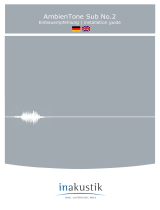 Inakustik AmbienTone Sub 2 Bedienungsanleitung
Inakustik AmbienTone Sub 2 Bedienungsanleitung
-
 Inakustik AmbienTone No.2 Bedienungsanleitung
Inakustik AmbienTone No.2 Bedienungsanleitung
-
Inakustik AmbienTone Slim Bedienungsanleitung
-
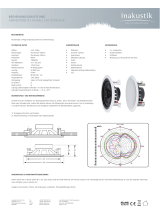 Inakustik AmbienTone R1 Bedienungsanleitung
Inakustik AmbienTone R1 Bedienungsanleitung
-
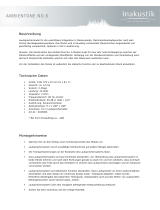 Inakustik AmbienTone No.6 Bedienungsanleitung
Inakustik AmbienTone No.6 Bedienungsanleitung
-
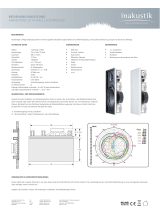 Inakustik AmbienTone Q1 Bedienungsanleitung
Inakustik AmbienTone Q1 Bedienungsanleitung
-
 Inakustik AmbienTone No.3 Bedienungsanleitung
Inakustik AmbienTone No.3 Bedienungsanleitung
-
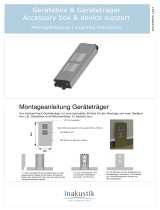 Inakustik AmbienTrack device support Bedienungsanleitung
Inakustik AmbienTrack device support Bedienungsanleitung























